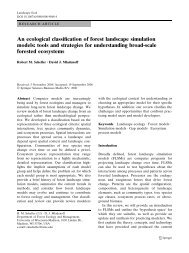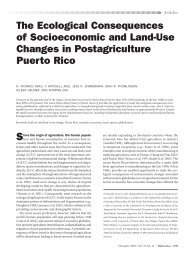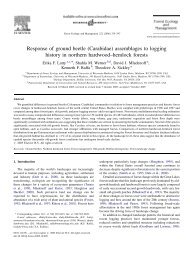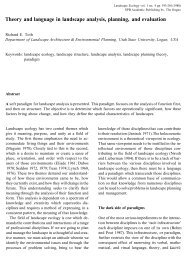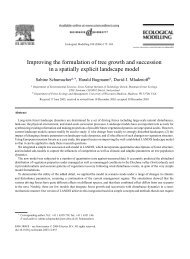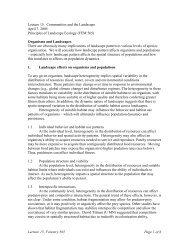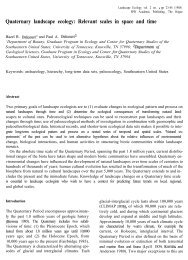732 L. R. Walker et al.Table 2. Relative appropriateness <strong>of</strong> the chronosequence approach varies depend<strong>in</strong>g on (a) predictability and trajectory type (divergent orconvergent) and (b) plant biodiversity and disturbance impact (frequency plus severity). ++Very <strong>use</strong>ful, +<strong>use</strong>ful, )not <strong>use</strong>ful, ))potentiallymislead<strong>in</strong>gDivergentConvergentPlant <strong>succession</strong> Soil development Plant <strong>succession</strong> Soil development(a)Predictable + + ++ ++Unpredictable ) ) + +Low disturbanceHigh disturbancePlant <strong>succession</strong> Soil development Plant <strong>succession</strong> Soil development(b)High biodiversity ) + )) )Low biodiversity + + +* or )† +*Progressive <strong>succession</strong>.†Retrogressive <strong>succession</strong>.Table 3. Guidel<strong>in</strong>es for develop<strong>in</strong>g appropriate chronosequence <strong>studies</strong> <strong>in</strong> terms <strong>of</strong> the elements needed and potential limitations <strong>of</strong> <strong>studies</strong> whenthese elements are miss<strong>in</strong>gElements neededTwo or more stages (duration <strong>of</strong> time series depends onparameter <strong>of</strong> <strong>in</strong>terest)Multiple stand characteristics that vary across stagesAt least one <strong>in</strong>dependent verification <strong>of</strong> time seriesReplication with<strong>in</strong> stages (number and spac<strong>in</strong>g depends onspatial heterogeneity)Sampl<strong>in</strong>g <strong>in</strong>tervals with<strong>in</strong> life span <strong>of</strong> every dom<strong>in</strong>ant species<strong>of</strong> <strong>in</strong>terest or duration <strong>of</strong> process <strong>of</strong> <strong>in</strong>terestMultiple visits to study plotsSere-appropriate measurementsStandardized measurementsPotential limitations if element is miss<strong>in</strong>gChronosequence study <strong>of</strong> ecosystem parameters onlyReduced ability to <strong>in</strong>terpret temporal dynamicsFaulty assumptions about temporal l<strong>in</strong>kagesMisrepresentation <strong>of</strong> stage characteristicsMissed stages, <strong>in</strong>accurate trajectoriesMiss<strong>in</strong>g verification <strong>of</strong> short-term dynamicsFailure to record relevant changesLack <strong>of</strong> ability to extrapolate to other <strong>studies</strong>experiments performed along both the progressive and retrogressivestages <strong>of</strong> the Hawaiian chronosequence (Vito<strong>use</strong>k2004) have greatly enhanced our understand<strong>in</strong>g <strong>of</strong> how the relativeimportance <strong>of</strong> nitrogen and phosphorus limitation <strong>in</strong>fluencesecosystem development both above and below ground.Similarly, plant removal experiments along a 6000-year,fire-driven chronosequence <strong>in</strong> northern Sweden (Wardle &Zackrisson 2005; Gundale, Wardle & Nilsson <strong>in</strong> press) haveclarified the shift<strong>in</strong>g l<strong>in</strong>kages between plant community compositionand soil biogeochemical processes dur<strong>in</strong>g <strong>succession</strong>.Although few manipulative experiments have been performedacross <strong>succession</strong>al gradients, such <strong>studies</strong> <strong>of</strong>fer tremendouspotential for better understand<strong>in</strong>g the role <strong>of</strong> both biotic andabiotic factors <strong>in</strong> driv<strong>in</strong>g community and ecosystem changedur<strong>in</strong>g <strong>succession</strong>.<strong>The</strong> appropriate <strong>use</strong> <strong>of</strong> <strong>chronosequences</strong> relies on at leastfive site-specific issues that serve as limitations, if not addressed(Table 3). First, <strong>chronosequences</strong> are most <strong>use</strong>ful when thereis a clear pattern <strong>of</strong> temporal change between multiple stages.Secondly, there should be several l<strong>in</strong>es <strong>of</strong> evidence about thehistory <strong>of</strong> the site. For short-term <strong>chronosequences</strong>, such evidencemight <strong>in</strong>clude oral histories, tree r<strong>in</strong>gs or historical maps,whereas for long-term <strong>chronosequences</strong>, these data might<strong>in</strong>clude good geographical or stratigraphic dat<strong>in</strong>g or biological<strong>in</strong>dicators such as micro- and macro-fossils. If such <strong>in</strong>dependentverification <strong>of</strong> a time series is present, the chronosequenceapproach is more likely to be justified. Thirdly, locat<strong>in</strong>g replicateplots randomly with<strong>in</strong> each stage <strong>of</strong> the chronosequence(not just the progressive phase), when possible, can helpaddress the structure <strong>of</strong> the (non-age-related) variation amongÓ 2010 <strong>The</strong> Authors. Journal compilation Ó 2010 British Ecological Society, Journal <strong>of</strong> Ecology, 98, 725–736
Chronosequences, <strong>succession</strong> and soil development 733chronosequence stages. Fourthly, if there are previously establishedplots that can be relocated, then earlier measurementscan be repeated <strong>in</strong> order to observe directly any subsequentchanges and verify chronosequence assumptions (e.g. Clarkson1997). F<strong>in</strong>ally, site-specific measurements must be made torecord relevant changes, but if these measurements do notemploy standardized methodology, extrapolations can be difficultto extend to other <strong>studies</strong>.ConclusionsWe agree with recent concerns that the mis<strong>use</strong> <strong>of</strong> <strong>chronosequences</strong>can mislead ecologists, particularly <strong>in</strong> relation to understand<strong>in</strong>gvegetation <strong>succession</strong>al pathways (Johnson &Miyanishi 2008). However, we do not believe that these problemsare sufficiently universal or severe to <strong>in</strong>validate their <strong>use</strong>for address<strong>in</strong>g questions about certa<strong>in</strong> types <strong>of</strong> ecosystemchange. <strong>The</strong> judicious <strong>use</strong> <strong>of</strong> chronosequence <strong>studies</strong> has greatlyadvanced our understand<strong>in</strong>g <strong>of</strong> short-term vegetation changewhere temporal connections have been confirmed (Foster & Tilman2000; Me<strong>in</strong>ers, Cadenasso & Pickett 2007). Chronosequenceshave also significantly aided our understand<strong>in</strong>g <strong>of</strong>long-term landscape processes (Milner et al. 2007) and soildevelopment (Walker & Syers 1976) and associated functionalchanges <strong>in</strong> above-ground and below-ground processes andorganisms (Vito<strong>use</strong>k 2004; Wardle, Walker & Bardgett 2004;Bardgett et al. 2005), even when the plant <strong>succession</strong>al trajectoriesdo not exactly parallel changes <strong>in</strong> soil development. Chronosequencesare most suited for measur<strong>in</strong>g plant and soilcommunity characteristics that change <strong>in</strong> a relatively predictive,l<strong>in</strong>ear fashion over time, such as plant cover and species richness,pedogenesis, soil organic matter accumulation and rates<strong>of</strong> ecosystem processes, and least suited for those traits that aremore diff<strong>use</strong> and less predictable such as species compositionand abundance. Further, <strong>chronosequences</strong> work better forstudy<strong>in</strong>g <strong>succession</strong>al trajectories that are convergent, have lowdiversity and are <strong>in</strong>frequently disturbed than for trajectoriesthat are divergent, more diverse and frequently disturbed.F<strong>in</strong>ally, <strong>chronosequences</strong> can <strong>of</strong>ten provide <strong>in</strong>formation criticalto manipulat<strong>in</strong>g <strong>succession</strong>al processes for restoration, evenwhere there is an imperfect understand<strong>in</strong>g <strong>of</strong> the ecosystem(Hobbs, Walker & Walker 2007). We ma<strong>in</strong>ta<strong>in</strong> that whenappropriately applied, the chronosequence approach <strong>of</strong>fers<strong>in</strong>valuable <strong>in</strong>sights <strong>in</strong>to temporal dynamics <strong>of</strong> vegetationchange and soil development that cannot be achieved <strong>in</strong> anyother way and that wholesale dismissal <strong>of</strong> this approach is morelikely to impede than to stimulate understand<strong>in</strong>g <strong>of</strong> these topics.AcknowledgementsWe thank Roger del Moral, Duane Peltzer, Elizabeth Powell and particularlyChris Fastie for stimulat<strong>in</strong>g discussions about this topic and Peter Bell<strong>in</strong>gham,Roger del Moral, Joe Walker and several anonymous referees for <strong>in</strong>sightfulcomments on the manuscript. Figure 1 is modified from contributions by ChrisFastie. L.R.W. was supported by the Department <strong>of</strong> Botany at the University<strong>of</strong> Hawaii at Manoa through the Wilder Chair Program and by the LuquilloExperimental Forest Long-Term Ecological Research Program (NSF grantDEB-0620910).ReferencesAlban, D.H. (1982) Nutrient accumulation by aspen, spruce, and p<strong>in</strong>e on soilproperties. Soil Science Society <strong>of</strong> America Journal, 46, 853–861.Aplet, G.H. & Vito<strong>use</strong>k, P.M. (1994) An age-altitude matrix analysis <strong>of</strong> Hawaiianra<strong>in</strong>-forest <strong>succession</strong>. Journal <strong>of</strong> Ecology, 82, 137–147.Armesto, J.J., Pickett, S.T.A. & McDonnell, M.J. (1991) Spatial heterogeneitydur<strong>in</strong>g <strong>succession</strong>: a cyclic model <strong>of</strong> <strong>in</strong>vasion and exclusion. Ecological Heterogeneity(eds J. Kolasa & S.T.A. Pickett), pp. 256–269. Spr<strong>in</strong>ger, NewYork.Ashton, P.S. (1985) Species richness <strong>in</strong> tropical forests. Tropical Forests (edsL.B. Holm-Hielsen, I.C. Nielsen & H. Balslev), pp. 239–251. AcademicPress, London.Avis, A.M. & Lubke, R.A. (1996) Dynamics and <strong>succession</strong> <strong>of</strong> coastal dunevegetation <strong>in</strong> the Eastern Cape, South Africa. Landscape and Urban Plann<strong>in</strong>g,34, 237–253.Baker, W.L. & Walford, G.M. (1995) Multiple stable states and models <strong>of</strong>riparian vegetation <strong>succession</strong> on the Animas River, Colorado. Annals <strong>of</strong> theAssociation <strong>of</strong> American Geographers, 85, 320–338.Bardgett, R.D. (2005) <strong>The</strong> Biology <strong>of</strong> Soil: A Community and EcosystemApproach. Oxford University Press, Oxford.Bardgett, R.D. & Walker, L.R. (2004) Impact <strong>of</strong> coloniser plant species on thedevelopment <strong>of</strong> decomposer microbial communities follow<strong>in</strong>g deglaciation.Soil Biology and Biochemistry, 36, 555–559.Bardgett, R.D., Bowman, W.D., Kaufmann, R. & Schmidt, S.K. (2005) A temporalapproach to l<strong>in</strong>k<strong>in</strong>g aboveground and belowground ecology. Trends <strong>in</strong>Ecology and Evolution, 20, 634–641.Bardgett, R.D., Richter, A., Bol, R., Garnett, M.H., Baumler, R., Xu, X.L.,Lopez-Capel, E., Mann<strong>in</strong>g, D.A.C., Hobbs, R.J., Hartley, I.R. & Wanek,W. (2007) Heterotrophic microbial communities <strong>use</strong> ancient carbon follow<strong>in</strong>gglacial retreat. Biology Letters, 3, 487–490.Benedetti-Cecchi, L. & C<strong>in</strong>elli, F. (1996) Patterns <strong>of</strong> disturbance and recovery<strong>in</strong> littoral rock pools: nonhierarchical competition and spatial variability <strong>in</strong>secondary <strong>succession</strong>. Mar<strong>in</strong>e Ecology Progress Series, 135, 145–161.Bhiry, N. & Filion, L. (1996) Holocene plant <strong>succession</strong> <strong>in</strong> a dune-swale environment<strong>of</strong> southern Quebec: a macr<strong>of</strong>ossil analysis. Ecoscience, 3, 330–342.B<strong>in</strong>kley, D. & Giard<strong>in</strong>i, C. (1998) Why do tree species affect soils? <strong>The</strong> warpand wo<strong>of</strong> <strong>of</strong> tree-soil <strong>in</strong>teractions. Biogeochemistry, 42, 89–106.Birks, H.J.B. (1980) Modern pollen assemblages and vegetational history <strong>of</strong> themora<strong>in</strong>es <strong>of</strong> the Klutlan Glacier and its surround<strong>in</strong>gs, Yukon Territory,Canada. Quaternary Research, 14, 101–129.Boerner, R.E.J. (1985) Alternate pathways <strong>of</strong> <strong>succession</strong> on the Lake ErieIslands. Vegetatio, 63, 35–44.Boerner, R.E.J., DeMars, B.G. & Leicht, P.N. (1996) Spatial patterns <strong>of</strong>mycorrhizal <strong>in</strong>fectiveness <strong>of</strong> soils along a <strong>succession</strong>al chronosequence.Mycorrhiza, 6,79–90.Brown, J.C. (1958) Soil fungi <strong>of</strong> some British sand dunes <strong>in</strong> relation to soil typeand <strong>succession</strong>. Journal <strong>of</strong> Ecology, 46, 641–664.Calk<strong>in</strong>, P.E. & Ellis, J.M. (1980) A lichenometric dat<strong>in</strong>g curve and its applicationto Holocene glacier <strong>studies</strong> <strong>in</strong> the central Brooks Range, Alaska. Arctic& Alp<strong>in</strong>e Research, 12, 245–264.Castillo, S., Popma, J. & Moreno-Casasola, P. (1991) Coastal sand dune vegetation<strong>of</strong> Tabasco and Campeche, Mexico. Journal <strong>of</strong> Vegetation Science, 2,73–88.Chadwick, O.A., Derry, L.A., Vito<strong>use</strong>k, P.M., Huebert, B.J. & Hed<strong>in</strong>, L.O.(1999) Chang<strong>in</strong>g sources <strong>of</strong> nutrients dur<strong>in</strong>g four million years <strong>of</strong> ecosystemdevelopment. Nature, 397, 491–497.Chap<strong>in</strong>, F.S., III, Matson, P.A. & Mooney, H.A. (2003) Pr<strong>in</strong>ciples <strong>of</strong> TerrestrialEcosystem Ecology. Spr<strong>in</strong>ger, New York.Chap<strong>in</strong>, F.S., III, Walker, L.R., Fastie, C.L. & Sharman, L.C. (1994) Mechanisms<strong>of</strong> primary <strong>succession</strong> follow<strong>in</strong>g deglaciation at Glacier Bay, Alaska.Ecological Monographs, 64, 149–175.Chazdon, R.L., Letcher, S.G., van Breugel, M., Mart<strong>in</strong>ez-Ramos, M.,Bongers, F. & F<strong>in</strong>egan, B. (2007) Rates <strong>of</strong> change <strong>in</strong> tree communities<strong>of</strong> secondary neotropical forests follow<strong>in</strong>g major disturbances. PhilosophicalTransactions <strong>of</strong> the Royal Society <strong>of</strong> London, Series B – BiologicalSciences, 362, 27–289.Christensen, N.L. & Peet, R.K. (1984) Convergence dur<strong>in</strong>g secondary forest<strong>succession</strong>. Journal <strong>of</strong> Ecology, 72, 25–36.Clarkson, B.D. (1997) Vegetation <strong>succession</strong> (1967–1989) on five recent montanelava flows, Mauna Loa, Hawaii. New Zealand Journal <strong>of</strong> Ecology, 22,1–9.Clarkson, B.R., Schipper, L.A. & Lehmann, A. (2004) Vegetation and peatcharacteristics <strong>in</strong> the development <strong>of</strong> lowland restiad peat bogs, NorthIsland, New Zealand. Wetlands, 24, 133–151.Ó 2010 <strong>The</strong> Authors. Journal compilation Ó 2010 British Ecological Society, Journal <strong>of</strong> Ecology, 98, 725–736



